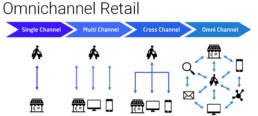Omnichannel Retail Marketing
Omnichannel – also spelled omni-channel – is a multichannel approach to sales that seeks to provide customers with a seamless shopping experience, whether they’re shopping online from a desktop or mobile device, by telephone, or in a brick-and-mortar store.
In 2018, worldwide ecommerce revenue reached nearly $2,300 billion.
A tech-savvy ecommerce marketer, manager, or business owner like yourself already knows that omnichannel retail is the only way to conduct business in the modern world—the toughest part is figuring out where the heck to start!
Compared to single-channel shoppers, retailers find that omnichannel shoppers
- Spend up to 35% more in an average transaction
- Increase profitability by up to 10% thanks to repeat business
- Have a 30% higher lifetime value.
Here are the 10 Omnichannel Retail Trends shaping the Industry in 2020
1. Omni-device Customers are the new norm.
The fact is shoppers use multiple devices, and multiple channels as well to complete the purchase process, this is what’s normal today. Google has found that 85% of digital consumers start the purchasing workflow on one device and then finish on another.
2. Customers expect a seamless checkout process on all channels
What does that mean for the most intensive part of the checkout process? As it stands, three-quarters of all online shoppers abandon their carts without ever completing their purchase. And the reason is hardly ever about how much the product costs but rather, surprise fees, a very time consuming account setup process shipping fees or delivery times.
Leading brands and retailers are exploring mobile and tablet point of sale systems in store, offering various payment options including Apple Pay and “buy now, pay later”, and overall streamlining the entire digital checkout process. All of these transactions now being performed on a seamless ecommerce platform and ERP system. Thus, bringing the omnichannel conversion system into one continuous flow from initial customer encounter to final checkout. This increases customer retention and repeat sales from multiple consumer access points.
3. Incorporating AI Drives in Cross-Channel Personalized Communications
Personalizing the consumer experience across every channel and device will continue to be one of the biggest trends in 2019 and beyond. And the growing accessibility of artificial intelligence, machine learning, and big-data processing tools only drives this trend that much further.
Now, even the “average” product marketer can leverage high-tech solutions to deliver personalized on-site product recommendations based on browsing and purchasing behavior, retarget shoppers on social media with personalized ads and promotions, segment users into relevant email marketing campaigns, and more.
4. Creative Fulfillment Strategies
As we have seen winning brands and retailed are listening to their consumers and going beyond the traditional fulfillment transaction. In 2020, online sellers will continue to offer online purchasing with in-store pickup, shipping from a local store, drop-shipping to your local store location, super fast shipping, super affordable (or free!) shipping, and even return labels that simplify the process of sending an item back.
Full Circle of Marketing for Conversion
Rainfire Media is currently working with Tint World to enable in-store purchase coordination with their POS and ecommerce platform, additional fulfillment strategies include online appointment scheduling, ecommerce shopping for automotive parts that will be drop-shipped to their store location and more. This is a perfect example of a omnichannel fulfillment system built for 2020 consumers. (https://tintworld.com)
5. Brick-and-Mortars that can change with the new landscape will thrive in this new retail environment
Operating a brick-and-mortar shop will continue to prove challenging in 2020. However, there is a growing trend among retailers who are being successful by scaling down inventory and services and focusing on something other than selling product – the shopper experience.
Shoppers no longer visit physical locations because they have to. They do it because they want to. Whether they desire to try out products or they just enjoy the social aspect of visiting your shop. Retailers who are winning at this strategy are providing knowledgeable and passionate sales associates in-store, special in-store-only products and promotions, an engaging store atmosphere that feels like and adventure (like Bass Pro Shops). Or host fun experiences that your products can enrich such as a fly fishing lessons, cooking class, a pop-up food stand, a hands-on building workshop (like Home Depot), an interesting speaker who uses your product, etc.
6. Brands are experiencing Augmented Reality
Augmented reality is all about empowering the consumer to bring the shopping experience into their home, their car, and even their liquor cabinet! For instance, IKEA’s Place app lets shoppers simulate how certain pieces of furniture will fit into a room, BMW has several apps that give consumers the wheel to view and design their very own vehicles, and The Macallan 12 AR Experience app invites consumers to take a (virtual) trip through the production process with a (real) drink in hand.
7. Voice Powered Commerce
It’s estimated that more than half of all internet searches will be conducted via voice-activated tools like Siri, Alexa, Google Home, and more by 2020. As for how that affects retail, in 2018 half of Americans had already used a voice assistant to make a purchase and another 25 percent reported they’d consider doing so in the future.
8. AI Chat Bots
By 2020, it’s thought that 85 percent of customer interactions will be handled without the need of a human agent. How? Chatbots. For online retailers, chatbots are invaluable in providing personalized, on-demand customer service that removes friction from the purchasing process. Again the omnichannel experience is streamlined for the consumer making it even easier to make that buy decision.
9. Ecommerce Subscription systems creates a whole new channel
The subscription-based ecommerce market has grown by more than 100 percent every single year for the past five years. The largest players generated over $2.6 billion in sales in 2016 alone. Even established retail giants are jumping on the trend in one way or another. Some examples are; Dollar Shave Club, Blue Apron, Sephora, Stitch Fix, etc.
10. Omnichannel support trends for online merchants
Customers can now visit their local Kohl’s store to return eligible Amazon items, without a box or label, for a free return. Kohl’s packages and sends returned items to Amazon returns centers on behalf of customers. It’s free, convenient and available to everyone just in time for back-to-school.
By supporting online sales, fulfillment and ease of returns retailers are making the buyer experience easier and more robust by combining forces and offering drop-off and pick-up services at brick-and-mortar partner locations. Look at the relationship with Kohls and Amazon, now you can by a product from Amazon and bring it back to Kohl’s who will package it up and send it back for a return for you. What does this do for Amazon you wonder? It saves the consumer time and effort in contacting the online retailer and waiting for a return slip and tracking down the mailman to send it back. It also provides a level of security of the return by offering in-store return management. What does Kohl’s get out of the deal? They get new clients, repeat clients and additional opportunities to service the customers needs by bringing them into the store location.





